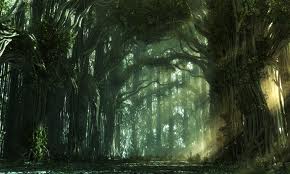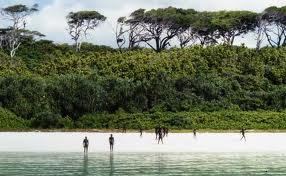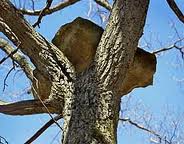Lost in the forest, I broke off a dark twig
and lifted its whisper to my thirsty lips:
maybe it was the voice of the rain crying,
a cracked bell, or a torn heart.
Something from far off it seemed
deep and secret to me, hidden by the earth,
a shout muffled by huge autumns,
by the moist half-open darkness of the leaves.
Wakening from the dreaming forest there, the hazel-sprig
sang under my tongue, its drifting fragrance
climbed up through my conscious mind
as if suddenly the roots I had left behind
cried out to me, the land I had lost with my childhood —
and I stopped, wounded by the wandering scent.
Pablo Neruda July 12, 1904 – September 23, 1973 : Parral, Chile
Forests cover approximately 9.4% of the Earth’s surface. However, they once covered over 50%.
Over 80% of Europe’s forests are owned by Russia.
In the forest you never know what is waiting around the corner.
I remember once when I was on a trip with some friends and we found this really creepy forest…..
 …………but enough of that…….here are some of the most unusual forests on our planet……..
…………but enough of that…….here are some of the most unusual forests on our planet……..
North Sentinel Island Forest
Located in the Bay of Bengal, it lies to the west of the southern part of South Adaman Island. It is unique because it is surrounded by coral reefs and lacks natural harbors; therefore, it was never settled by Europeans and deforested. The island is almost completely covered in old growth trees and is home to the last pre-Neolithic tribe known as the Sentinelese.
The Sentinelese maintain a hunter-gatherer society, obtaining their subsistence from the forest through hunting, fishing and collecting wild plants.
The Crooked Forest is a grove of oddly shaped pine trees outside the village of Nowe Czarnowo, in western Poland.
The forest contains about 400 pine trees that grow with a 90 degree bend at the base of their trunks
All the trees are bent northward and are surrounded by a larger forest of straight growing trees.
The trees were planted around 1930 when the area was inside the German province of Pomerania.
It appears the trees were formed with a human tool and allowed to grow 7 to 10 years before being held down and warped by a device.
The exact reason why the Germans wanted to make crooked trees is still unknown.
Red Forest
The Red Forest or the Worm Wood Forest is located within the 10 kilometer (6.2 mile) area surrounding the Chernobyl Nuclear Power Plant, near the city of Pripyat, Ukraine.
After the Chernobyl nuclear accident on April 26, 1986, the forest turned a ginger-brown color and died.
The trees were bulldozed and buried, covered with sand and planted over with new pine saplings.
Today the Red Forest remains one of the most contaminated areas in the world.
More than 90% of the radioactivity is concentrated in the soil.
Since 1986, the population of wild boar in the Red Forest has exploded.
The area has become home to a large collection of wild species, including storks, wolves, beavers, lynx, elk and eagles.
Birds have been observed nesting in the old nuclear reactors and many endangered species have been spotted.
The Chernobyl Exclusion Zone now encompasses more than 1,600 square miles of northern Ukraine and southern Belarus, a ragged swatch of forests, marshes, lakes and rivers.
Chestnut Hills
The largest remaining forest of American Chestnut trees is named Chestnut Hills and is near West Salem, Wisconsin.
The chestnut blight struck the American chestnut tree and caused mass extinction between 1900 and 1940.
These marvelous trees once grew as tall as 200 feet and had a trunk diameter of 14 feet.
The blight was caused by the C. parasitica and was accidentally introduced to North America either through imported chestnut lumber or through imported chestnut trees.
About 4 billion American chestnut trees were lost in the blight.
Today there are approximately 2,500 chestnut trees on 60 acres of land.
The chestnuts are the descendants from only a dozen trees planted by Martin Hicks in the late 1800s.
In 1987, scientists discovered C. parasitica in the trees and the blight has been slowly killing the forest.
Another small stand of trees was found in Franklin Delano Roosevelt State Park
near Warm Springs, Georgia on April 22, 2006.
Sea of Trees
The Sea of Trees or Aokigahara is a forest located at the northwest base of Mount Fuji in Japan.
The forest contains many hidden caverns and giant trees. It is very dark and has thick growth.
Aokigahara has an absence of wildlife and is known for being an eerily quiet place.
The forest is known for being the place for suicide.
In 2004, 108 bodies were found in the forest.
It is reported that in 2010, 247 people attempted suicide in the forest.
The Sea of Trees is the world’s second most popular suicide location after San Francisco’s Golden Gate Bridge.
Trillemarka – Rollagsfjell Forest
Trillemarka – Rollagsfjell Forest is located in Buskerud, Norway.
It was created on December 13, 2002, and is located in the mountain areas between Nore in Numedal and Solevann in Sigdal.
The forest is the last ancient wilderness forests of Norway. The land has all the qualities of the original Norwegian forests, including untouched valleys, rivers, lakes and very old trees.
Trillemarka – Rollagsfjell is home to 93 red listed and endangered species.
These species include: Lesser Spotted Woodpecker, Tree-toed Woodpecker, Siberian Jay, Stock Dove and Golden Eagle.
Dark Entry Forest
Dark Entry Forest s located in a Connecticut State Forest, but sits on private land near the Mohawk State Forest and Mohawk Trail.
Dudley Town is a ghost town in Cornwall, Connecticut; it was founded in the mid-1740s and was a thriving community at one time.
The the strange sightings, unexplained murders and mass suicides started.
By the middle of the 20th century everyone in the town had either died or moved away.
It sits in the shadow of three separate mountains: Bald Mountain, Woodbury Mountain and the Coltsfoot Triplets.
The area is also know for a large collection of orbs, unexplained lights and bizarre sounds.
Yikes!!!
Ardennes
The Ardennes is a region of extensive forests, rolling hills and ridges in Belgium, Luxembourg and France.
The Ardennes holds a strategic position in Europe, for this reason a large number of famous battles have been fought on the land.
Battle of the Ardennes – 1914
Battle of France -1940
Battle of the Bulge – 1944
Today the Ardennes is popular for hunting, cycling, walking, canoeing and its historic landmarks.
Hoia-Baciu Forest
The Hoia-Baciu Forest is located near Cluj-Napoca, Romania and is referred to as the Bermuda Triangle of Romania.
The forest is named after a shepherd that disappeared in the area with two hundred sheep.
Many of the locals who have gone into the forest complain of physical harm: rashes, nausea, vomiting, migraines, burns, scratches, anxiety and other unusual bodily sensations.
The Hoia-Baciu has a reputation for paranormal activity, including: orb-like lights, female voices, giggling, apparitions and cases of people being scratched.
Some people who enter the forest suddenly remember all of their past experiences in the trees, but then forget the memories after leaving the forest.
Scientists from Germany, France, Hungary and The United States have managed to capture bizarre material structures on film, including faces and apparitions.
Ancient Wuda Forest
In February, 2012, scientists in northern China announced that they had finished reconstructing an ancient forest that was found buried under a thick layer of volcanic ash near the Mongolian district of Wuda.
The 20 square kilometer forest was completely preserved after a large volcano erupted 298 million years ago.
Scientists from the University of Pennsylvania, Shenyang Normal University and Yunnan University have been able to reconstruct 10,000 square feet of the subtropical forest.
In all, six different species of trees have been identified in the preserved forest, including the tall Sigillaria, Cordaites, and smaller spore-bearing Noeggerathiales,which is believed to be related to the Fern Family.
Yellowwood State Forest
The Yellowwood State Forest is located in Brown County, Indiana.
The name is derived from the yellowwood, a tree seldom found this far north in the United States.
The Yellowwood State Forest was established in the 1930s.
A major mystery surrounds the forest.
A collection of large sandstone boulders, estimated to weigh about 400 pounds have been found in the tops of three trees.
The mystery began in the 1990s, when a turkey hunter discovered a large boulder in a chestnut oak tree.
The boulder was dubbed Gobbler’s Rock.
Ode to Trees
The sweet scent of nature overshadows
the rough bark and smooth leaves of the trees,
the wind dancing with them as they glide gracefully among the dirt,
whispering lost stories to each other that were passed on to them from the great ancient one.
The trees, some tall some little, all gathering together as one family
These long, brown, and old beings resting
and providing homes and protecting the many animals living in them.
The trees give us all something — a box, a chair, even a house
but never ask anything back
Meera (a 5th Grader) November 1, 2008













I love the opening and close: Pablo Neruda and a 5th grader. Simply lovely. A peaceful piece. Much needed. MER
Wonderful- just wonderful
Thank you Sir Lawrence. Welcome back to the land of Oz! We must have wine soon!
Well done all around! I will continue to avoid dark forests – I knew there was a reason I live on the coast. Great post!
Thank you! ………….and yes it is creepy! Ihave always liked the dark forest, but have always felt a sense of unease when in one ………… now I know why!
Now I know why Forests are so creapy……….But still very fascinating! I loved it……..
Ana
I am so very glad that you enjoyed.
I think that I will never see. A poem as lovely as a tree. Alfred Joyce Kilmer must have been standing over your shoulder when you wrote this post, Tin Man. No wonder they told the teddy bears “not to go down to the woods alone”. This is a post one returns to again and again. Virginia
Thank you so for your kind words, Virginia!
I’ve never heard of the crooked forest before, but it doesn’t surprise me at all that Germans made it. They had a lot of unnatural ideas about planting and reforming forests in the 19th/early 20th centuries, Great post!
I feel lush, thank you! The crooked ones are so out of this world. Super super super! xx
Thank you so very much! We are having heat of over 100 degrees everyday here and the forest feels so very inviting! I am so glad you enjoyed.
Well, Mumbai finally tasted the ‘Mumbai’ rains. It’s been a good soaked week here. Smells fresh 🙂
An oldie but quite a goodie.
Those crooked trees in the Crooked Forest look like they are kneeling in homage to — Something. Someone. Who knows?
How mysterious forests are! And didn’t we always have a feeling that was so? Surely Hansel and Gretel did.
You manage to gather the most interesting assortments of material, Emil!
Oh………..marvelous to see you back here in time. This was one of my favorite posts to research. I learned much and had fun. Thanks for stopping by!